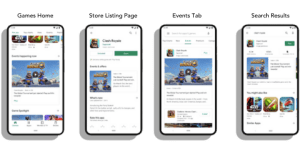For The Drum’s Retail Focus, Remerge’s team of mobile marketing experts discuss four ways that retail businesses can grow their mobile app and drive revenue through programmatic in-app advertising.
As consumer spending habits have moved increasingly online, retail businesses must find new ways to engage customers and enhance their shopping experiences. One of the most effective ways to do this is through their mobile apps. Soaring usage of smartphones combined with the harvesting of customer data has led to the advent of programmatic in-app advertising – a channel that is truly transforming the way brands reach and engage their customers.
What is in-app advertising and how does it work?
Programmatic in-app advertising refers to the automated buying of in-app ad placements using algorithms and real-time data. This process is governed by AI and machine learning technologies that are managed by advertising partners called demand side platforms (DSPs). Their sophisticated algorithms optimize the buying, placement and targeting of these ads. In simple terms, in-app advertising, allows brands to advertise their business (or their own app), by running self-optimizing ad campaigns that are shown within third-party mobile apps that their customers engage with.
Here are four ways that programmatic in-app advertising can help retailers drive revenue and retention through their mobile apps.
1. Creating personalized ad experiences
For retail apps, one of the major benefits of in-app advertising is the ability to deliver highly personalized product recommendations in the form of ads. By leveraging customer data such as purchase behavior and demographic information, retail apps can partner with a DSP to reach users based on their individual preferences. Amazon, for example, was one of the first companies to master personalized product recommendations by analyzing browsing and purchase data in order to recommend products that are most likely to drive engagement and sales.
This level of personalization is particularly useful for dynamic product ads (DPAs), in which the visuals and copy texts of an ad can be populated, tested and rotated in real time, based on the attributes of the user who is being targeted by the ad. A user with an interest in running for example, may respond well to sportswear ads from a retail app, so it would make sense to show them a carousel ad that is populated with a variety of sportswear items for runners. Delivery of relevant ads will not only boost sales for the sportswear retailer, but it will make customers feel valued and understood, which in turn can fuel brand loyalty.
Geo-targeting is another way to personalize the shopping experience for end users. Retailers can use location data to send customers localized offers and promotions based on their current or past locations. For example, a customer near a physical store might be shown an ad about an ongoing sale or a new product launch, prompting them to buy something over the counter. Another offer could be that customers in a certain region get free shipping on all in-app purchases for that particular day.
Using deep links for in-app ad campaigns is another great way to personalize and streamline the user experience for existing customers of retail apps. Because the user already has the app installed on their phone, a single click is all it takes to direct them to a specific in-app product page. This reduces friction in the customer journey and makes it both easier and faster for users to find and purchase what they want.
Amanda Vandiver from Branch describes it in an episode of the Apptivate podcast as: “Creating that connection between the share-point and the person on the other end opening the app – to ensure they are taken to the right place.”
2. Increasing scale and efficiency
Because the bidding and buying process for in-app ad placements is governed and automated by machines, it allows retail businesses to reach a wider audience with minimal need for manual intervention. By automating these processes, retailers can globally scale their advertising efforts across a variety of apps and platforms. This scalability is crucial for retailers wanting to expand their reach quickly and efficiently, while ensuring that their ads are shown to the right users at the right times.
In-app advertising isn’t just scalable and time efficient, but it’s also a high-performing and cost effective channel as well. An article by Publift claims that “in-app ads have a click through rate (CTR) of 0.56% compared to 0.23% for mobile web ads.”
In-app advertising relies on machine learning and artificial intelligence to analyze and adjust ad placements based on performance data. This means that underperforming ads are automatically replaced with higher-performing ones to ensure optimal use of advertising budgets. Retailers can define specific performance metrics and KPIs with their DSP partner, whose algorithms will adjust the bids and placements accordingly to meet these goals.
3. Driving retention and loyalty through retargeting
Retail apps can also use in-app advertising for their retargeting campaigns. Retargeting through this channel can help retailers improve retention rates and increase customer lifetime value (CLTV) among their existing users. This can be done via ads that promote loyalty schemes, exclusive discounts, and personalized offers. Through such retargeting strategies, retail apps can ramp up user engagement and encourage a variety of in-app interactions to foster loyalty among users.
Retargeting ads can also be tailored to remind users of items they have viewed or added to their cart but not purchased, and may later prompt them to complete the transaction. Ads can also highlight new app features or exclusive products that align with the user’s preferences, which in turn helps to keep the app interesting and relevant. By continuously delivering value through personalized ad content, retail apps can maintain user interest and encourage consistent engagement to increase overall retention rates.
Loyalty schemes and reward programs are another way to garner customer loyalty – and in-app retargeting can play a crucial role in promoting these initiatives. Retail apps can use targeted ads to inform users about the benefits of joining a loyalty program, such as earning points for purchases, receiving early access to sales or benefiting from ‘refer a friend’ incentives.
By advertising these perks, retailers can easily grow their loyalty programs. Retargeting ads can even be used to remind existing customers about their point balances, upcoming rewards, and how close they are to achieving the next tier of benefits. In the long run, this can contribute to an increase in the average user’s CLTV.

4. Creating brand awareness and an omnichannel presence
Aside from the traditional conversion-based metrics and KPis that in-app retargeting sets out to address, it’s also a great way for retailers to spread general awareness for their brand. In-app advertising is an important component in establishing an omnichannel presence because it helps retailers to find new customers who may not be reachable through offline channels or social media. Consistent exposure across multiple channels is the key to building widespread brand recognition and familiarity.
The data collected from programmatic campaigns can also provide valuable insights into customer behaviors and preferences, which can then inform broader marketing strategies and activities across other channels. By understanding user behavior across different platforms, retailers can make smarter marketing decisions and use this information to adjust and distribute their ad spend more effectively.
Although being present across multiple channels is important, retailers should ensure that their branding and messaging remains consistent across all platforms and uphold internal branding guidelines. Retailers should also be careful not to bombard users with the same ads across all channels, but instead aim to achieve a balance. The use of frequency capping can help reduce ad fatigue and the regular rotation of creatives will keep ads fresh and engaging.
Executive summary
Programmatic in-app advertising in partnership with a trusted DSP partner like Remerge is an effective way to boost revenue and customer engagement. Using algorithms and real-time data to optimize ad placements allows retailers to scale marketing efforts efficiently, deliver highly personalized ad experiences, and enhance customer retention and loyalty.
Strategies such as personalized product recommendations, geo-targeted promotions, and dynamic ads all help to improve brand loyalty. CLTV and the overall user experience, while the automation behind programmatic ad buying ensures optimum cost-efficiency.
In-app advertising also plays a crucial role in building general awareness and helps to establish a multi-channel presence, which brands need more than ever in an increasingly competitive digital world.




